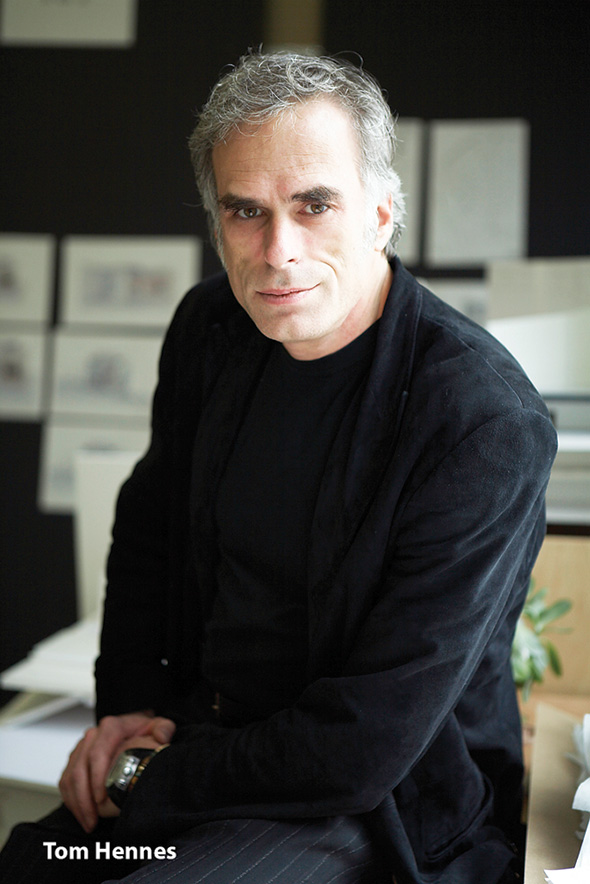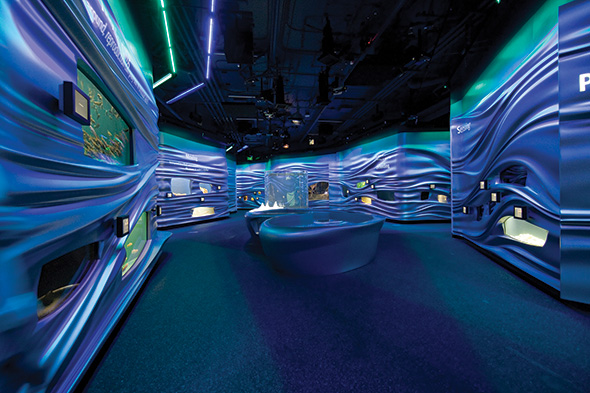Tom Hennes ‘Thincs’ things through.


The Nickelodeon slime machine is an icon in many of the imaginings of my generation, and somewhere during my less formative years, which roughly took place between a drippy popsicle and impending puberty, Tom Hennes designed the Nickelodeon Green Slime Geyser. Hard to believe that the company that perfected green phlegm erupting from a colossal Frankenstein-esque chemistry set would have also been responsible for designing the Memorial Museum at Ground Zero. But if you are familiar with Tom Hennes and the dizzying array of design work that he does, this seemingly vast disparity would barely flutter an eyelash.
Tom Hennes founded his exhibition design firm, Thinc, in 1992 but his interest began long before with theatre design, an ostensibly crucial crux to his design milieu: immersion and interaction. When you look over Hennes’ long list of accomplished spaces—from museums and memorials to aquariums and conference sites—all of his work deals with a collective unconscious and social memory. So what better way to serve that trope than to implicate the viewers into the very existence of the structures and the ideas that they represent.
Hennes has divined a way to incorporate his interest in environmental responsibility with his unique design aesthetics through interactive technologies and responsible site construction, all of which the viewer is invited to participate in and inform. A predilection for international adventures of all sorts (which does not exclude an interest in Sony PlayStation, mind you), gives Hennes the advantage of experiencing the world as a global entity, which his designs reflect. From San Francisco to China to South Africa, there is an undeniable connectivity and joie de vivre in all of his work. Fortunately for SF he has turned his eye toward its beloved Golden Gate Park.
Inclement weather keeps many a San Franciscan from fully enjoying the fruits and bounty of the sea, so Thinc has brought it to us with the aid of architectural firm A&O. The beautifully renovated California Academy of Sciences, which initially began as a transitional space for the museums aquatic residences in 2003, was soon transformed into the new and improved Steinhart Aquarium, opened September 27 of this year. La couer de couer of this overwhelming exhibition is the Water Planet. Central to the layout of the aquarium, physically, conceptually and personally, Tom worked in partnership with A&O whose principal, Joe McDonald, is Tom’s life partner. The two wed two days before the opening, c’est l’amore!
The aquarium is a virtual Noah’s Ark with its cornucopia of life—38,000 critters to be precise—and a 197,000 square- foot “living rooftop.” The rooftop is complete with a wild flower meadow and seven rolling hillocks, intended to mimic the tumulus topography that distinguishes the San Francisco cityscape. Thinc has further improved upon this ark with sustainable design, an increasingly familiar modus operandi of Hennes’, and a hallmark of his interest as a staunch environmentalist. Not coincidentally, this über-conscientious method of construction lends itself seamlessly to his immersion design ethic. Blending the Steinhart with its immediate surroundings contextualizes the building not only as a city park and museum, but an integration of the collected experiences of its visitors.
Hennes’ interest in world history and culture has often led him and his team outside of the United States. Heritage museums such as South Africa’s Freedom Park, slated to open in phases between 2009 and 2010, is a site of historical investigation and interaction. The Freedom Museum commemorates those who were brutalized or killed during apartheid, but its primary aim is to create a communal space for informed dialogue. This very interplay of history and archive in design is not novel to Hennes and consequently brought Thinc to the Netherlands. The Ministry of Culture commissioned Thinc because of their pronounced interest in the roles of history and nationality, and the debate that they spark (implications reach further than wooden shoes and wheels of cheese). The Ministry of Culture project combined the Royal Library, the National Archives, the Institute of Art History, the Literary Museum and the Genealogical Institute, and the result is a museum that is as about as comprehensive as they come. So how does one compress all of this information into a single museum, barring access to the Star Trek database? Hennes and his team decided that the best way to make information relevant would be to allow guests to peruse contemporary materials and contextualize them via all of the resources, data and materials from the collective institutions. Interactive galleries that include internet technologies and contrasting curatorial positions encourage visitors to interact with the materials and formulate informed individual opinions.
So how does Hennes get all of this done? You would think he is a slave driver, the Anna Wintour of conscientious design, all dressed up in a hemp fabric Chanel suit. But alas, his employees love him (unless the ones who don’t are hidden in a basement) they have nothing but glowing adulations for Hennes and Thinc—adjectives like innovative, caring, fun, intuitive, thoughtful, down to earth. His affable character makes it no surprise that he’s been asked to teach at such prestigious schools as RISD and Pratt Institute, sharing with the world’s future shapers and molders the way in which he makes his integrative designs seem so effortless.
Not since Heidi Fleiss has someone been so successful at perfecting the craft of hands on interactive experience— loved by their colleagues and thousands of on-site visitors.
TEXT BY Sophia Dearborn

